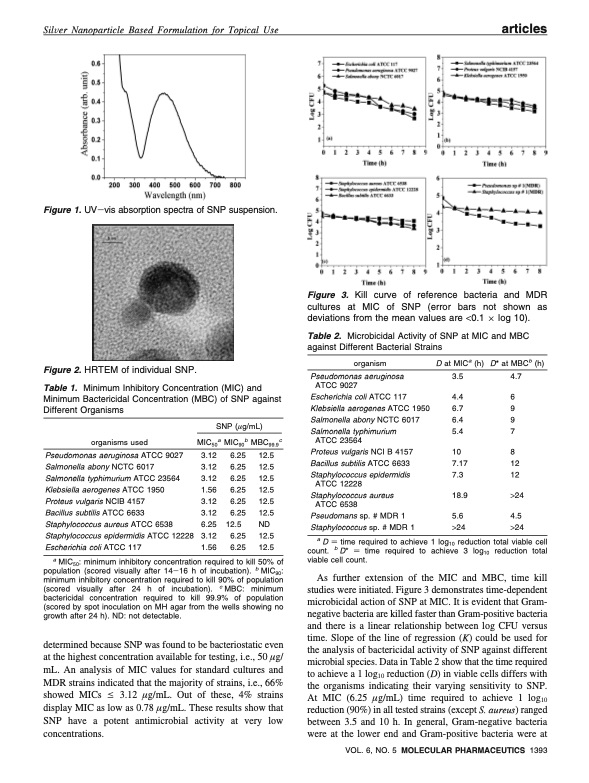
PDF Publication Title:
Text from PDF Page: 007
SilVer Nanoparticle Based Formulation for Topical Use articles Figure 1. UV-vis absorption spectra of SNP suspension. Figure 2. HRTEM of individual SNP. Table 1. Minimum Inhibitory Concentration (MIC) and Minimum Bactericidal Concentration (MBC) of SNP against Different Organisms Figure 3. Kill curve of reference bacteria and MDR cultures at MIC of SNP (error bars not shown as deviations from the mean values are <0.1 × log 10). Table 2. Microbicidal Activity of SNP at MIC and MBC against Different Bacterial Strains SNP (μg/mL) MIC50a MIC90b MBC99.9c organism Pseudomonas aeruginosa ATCC 9027 Escherichia coli ATCC 117 Klebsiella aerogenes ATCC 1950 Salmonella abony NCTC 6017 Salmonella typhimurium ATCC 23564 Proteus vulgaris NCI B 4157 Bacillus subtilis ATCC 6633 Staphylococcus epidermidis ATCC 12228 Staphylococcus aureus ATCC 6538 Pseudomans sp. # MDR 1 Staphylococcus sp. # MDR 1 D at MICa (h) D* at 3.5 4.4 6.7 6.4 5.4 10 7.17 7.3 18.9 5.6 >24 MBCb (h) 4.7 6 9 9 7 8 12 12 >24 4.5 >24 organisms used Pseudomonas aeruginosa ATCC 9027 3.12 6.25 12.5 Salmonella abony NCTC 6017 3.12 6.25 12.5 Salmonella typhimurium ATCC 23564 3.12 6.25 12.5 Klebsiella aerogenes ATCC 1950 1.56 6.25 12.5 Proteus vulgaris NCIB 4157 3.12 6.25 12.5 Bacillus subtilis ATCC 6633 3.12 6.25 12.5 Staphylococcus aureus ATCC 6538 6.25 12.5 ND Staphylococcus epidermidis ATCC 12228 3.12 6.25 12.5 Escherichia coli ATCC 117 1.56 6.25 12.5 a D ) time required to achieve 1 log10 reduction total viable cell count. b D* ) time required to achieve 3 log10 reduction total viable cell count. As further extension of the MIC and MBC, time kill studies were initiated. Figure 3 demonstrates time-dependent microbicidal action of SNP at MIC. It is evident that Gram- negative bacteria are killed faster than Gram-positive bacteria and there is a linear relationship between log CFU versus time. Slope of the line of regression (K) could be used for the analysis of bactericidal activity of SNP against different microbial species. Data in Table 2 show that the time required to achieve a 1 log10 reduction (D) in viable cells differs with the organisms indicating their varying sensitivity to SNP. At MIC (6.25 μg/mL) time required to achieve 1 log10 reduction (90%) in all tested strains (except S. aureus) ranged between 3.5 and 10 h. In general, Gram-negative bacteria were at the lower end and Gram-positive bacteria were at a MIC50: minimum inhibitory concentration required to kill 50% of population (scored visually after 14-16 h of incubation). b MIC90: minimum inhibitory concentration required to kill 90% of population (scored visually after 24 h of incubation). c MBC: minimum bactericidal concentration required to kill 99.9% of population (scored by spot inoculation on MH agar from the wells showing no growth after 24 h). ND: not detectable. determined because SNP was found to be bacteriostatic even at the highest concentration available for testing, i.e., 50 μg/ mL. An analysis of MIC values for standard cultures and MDR strains indicated that the majority of strains, i.e., 66% showed MICs e 3.12 μg/mL. Out of these, 4% strains display MIC as low as 0.78 μg/mL. These results show that SNP have a potent antimicrobial activity at very low concentrations. VOL. 6, NO. 5 MOLECULAR PHARMACEUTICS 1393PDF Image | Silver Nanoparticles in Therapeutics: Antimicrobial Gel

PDF Search Title:
Silver Nanoparticles in Therapeutics: Antimicrobial GelOriginal File Name Searched:
SilverNanoparticlesinTherapeutics-TopicalUse.pdfDIY PDF Search: Google It | Yahoo | Bing
Turbine and System Plans CAD CAM: Special for this month, any plans are $10,000 for complete Cad/Cam blueprints. License is for one build. Try before you buy a production license. More Info
Waste Heat Power Technology: Organic Rankine Cycle uses waste heat to make electricity, shaft horsepower and cooling. More Info
All Turbine and System Products: Infinity Turbine ORD systems, turbine generator sets, build plans and more to use your waste heat from 30C to 100C. More Info
CO2 Phase Change Demonstrator: CO2 goes supercritical at 30 C. This is a experimental platform which you can use to demonstrate phase change with low heat. Includes integration area for small CO2 turbine, static generator, and more. This can also be used for a GTL Gas to Liquids experimental platform. More Info
Introducing the Infinity Turbine Products Infinity Turbine develops and builds systems for making power from waste heat. It also is working on innovative strategies for storing, making, and deploying energy. More Info
Need Strategy? Use our Consulting and analyst services Infinity Turbine LLC is pleased to announce its consulting and analyst services. We have worked in the renewable energy industry as a researcher, developing sales and markets, along with may inventions and innovations. More Info
Made in USA with Global Energy Millennial Web Engine These pages were made with the Global Energy Web PDF Engine using Filemaker (Claris) software.
Infinity Turbine Developing Spinning Disc Reactor SDR or Spinning Disc Reactors reduce processing time for liquid production of Silver Nanoparticles.
| CONTACT TEL: 608-238-6001 Email: greg@infinityturbine.com | RSS | AMP |